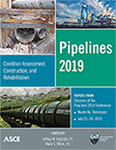Pipelines 2019
Pipeline Ovality Assessment at Low Internal Pressures
Publication: Pipelines 2019: Condition Assessment, Construction, and Rehabilitation
ABSTRACT
While pipe ovalization is a common occurrence during the manufacturing of pipe sections, ovalization can also occur in pipelines during and after installation and construction. To determine the acceptability of newly constructed sections of pipeline, inline inspection (ILI) tools, or pigs, are often run to measure ovality. However, the ILI tool often flags numerous locations that do not satisfy the maximum allowable ovality criteria of 5% required by CSA Z662 (3%–6% if limit states design was used). This is possibly due to external forces (e.g., soil cover) and the low internal pipeline pressure used to run the ILI tool. It is postulated that these non-satisfactory ovality readings would not be present at higher internal pressures (i.e., operating pressures). The major objective of this study is to better understand the relationship between internal pipeline pressure and other variables with the ovality measurement. Based on results from elastic finite element analyses (FEA) of different pipe sections and loading conditions, equations are proposed to estimate pipeline ovality based on depth of cover, pipe geometric and material properties, and internal pressure (represented by a “deflection parameter”, α). A quadratic equation, as well as a simplified linear equation, were developed in this study. These equations, based on 68 different FEA load cases, can be used as a screening tool to estimate the ovality of a pipe section. Whichever equation (i.e., linear or quadratic) is used to predict the ovality in a pipe section, the deflection parameter, α, provides a means of summarizing overall trends. For example, if the pipe stiffness is increased, α (and thus ovality) decreases. Conversely, if overburden pressure is increased, α increases. Finally, if the internal pressure stiffening is increased, α decreases. The last observation is the most critical for this study as internal pressure is the most practical mitigation for reducing the number of ovalities flagged by an ILI tool post-construction. Increasing internal pressure has the additional benefit of improving the quality of the measurement data by reducing/eliminating “surging” of the ILI tool (i.e., erratic velocity changes due to sticking and slipping of the tool).
Get full access to this article
View all available purchase options and get full access to this chapter.
REFERENCES
Abaqus/CAE User’s Guide, Dassault Systèmes, 2017.
American Lifelines Alliance (ALA), Guidelines for the Design of Buried Steel Pipe, July 2001.
ANSI/API Specification 5L, Specification for Line Pipe, American Petroleum Institute, December 2012.
Canadian Energy Pipeline Association (CEPA) Foundation, Construction Best Practices: Prevention of Dents and Ovalities in Pipeline Construction.
Canadian Institute of Steel Construction (CISC), Handbook of Steel Construction, March 2017.
Canadian Standards Association (CSA) Z662-15, Oil and Gas Pipeline Systems, March 2016.
Information & Authors
Information
Published In
Pipelines 2019: Condition Assessment, Construction, and Rehabilitation
Pages: 300 - 310
Editors: Jeffrey W. Heidrick, Burns & McDonnell and Mark S. Mihm, HDR
ISBN (Online): 978-0-7844-8249-0
Copyright
© 2019 American Society of Civil Engineers.
History
Published online: Jul 18, 2019
Published in print: Jul 18, 2019
Authors
Metrics & Citations
Metrics
Citations
Download citation
If you have the appropriate software installed, you can download article citation data to the citation manager of your choice. Simply select your manager software from the list below and click Download.
